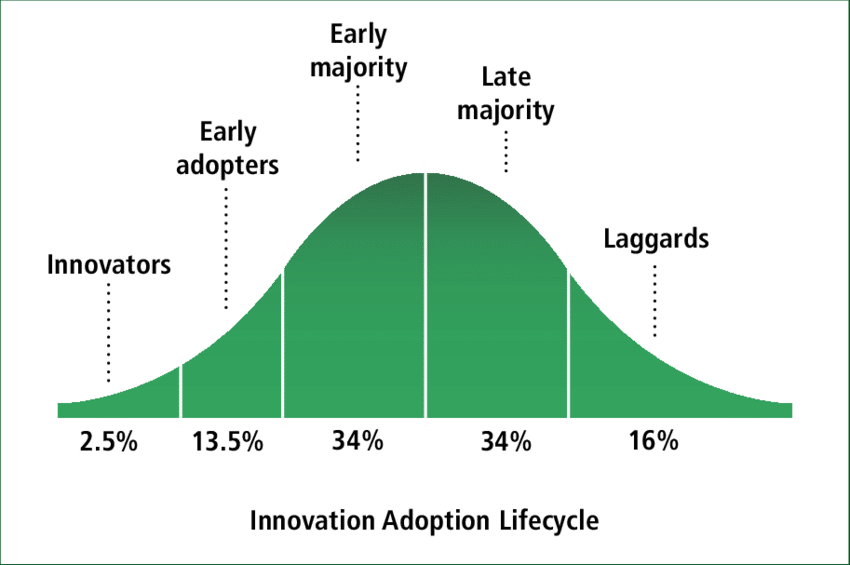Introducing new technologies is a vital part of adapting to changing business needs.
Take 2020 as an example. The impact of the pandemic on work-life culture has been extraordinary. More and more people are accepting technological change and adopting novel technologies. Remote work is no longer just for freelancers. It’s an increasingly common business process for large teams in a wide range of organizational settings.
And in order to support their employees through this seismic shift, the best employers understand that not everyone’s the same.
Different people react to innovation differently. Technology acceptance and compatibility are variable. Luckily, the technology adoption lifecycle is a straightforward way to understand how your employees may respond to new tech. Generally, workers will fall into one of five categories. Understanding these and what they mean for your business’s new tech is useful for any businesses embarking on a period of significant change.
What is technology adoption and why is it important?

Technology adoption is sometimes referred to as a lifecycle, and it’s about more than just the implementation of new information technologies.
Adoption behavior is just as much about the ways in which new technologies are accepted by individuals or organizations. How does this new technology become integrated into accepted social and/or organizational practices?
The introduction of innovations to your workforce doesn’t end at installation. Companies must be aware that different employees will react to technology in different ways. A one-size-fits-all launch initiative might save time now, but it will cost you in the long run.
To protect your business’s ROI and get the most out of your new technology, flexible technology implementation procedures are far more effective. By customizing the launch approach, you’ll make unfamiliar technology accessible to every employee.
When every employee is on board and feels able to utilize technology effectively, your business will start seeing results. By basing a launch approach on adoption theory, businesses minimize employee resistance and increase their chances of success.
So, what is the adoption theory?
The five customer segments of technology adoption
Sociologists have extensively studied the trends behind technology adoption. As a result, they’ve come up with a widely accepted sociological bell-curve technology acceptance model.

Source
This model of adoption behaviors suggests five standard types of adopter groups, each shown on the curve above. So what are the five adopter categories and what are their characteristics?
The five types of adopter group
- Innovators
- Early adopters
- Early majority
- Late majority
- Laggards
You’ve probably already met employees from each of these categories along the adoption curve in your day-to-day life. Let’s get to know each of them a little bit better. By knowing what works best for them, we’ll ensure the diffusion of incoming technology without too many roadblocks along the way.
1. Innovators
Innovators make up 2.5% of employees. Innovators are the first individuals to adopt a new innovation. They tend to be young, middle-class, and financially stable, with a wide social network and characteristic willingness to take risks.
Because of this, innovators are willing to experiment with new technological trends in the knowledge that, ultimately, they might not be successful. Typically, innovators are equally willing to adopt new technologies in both the workplace and their own personal lives.
2. Early adopters
Early adopters make up 13.5% of employees. After innovators, they are the second fastest group to adopt new innovations. Like innovators, early adopters tend to be young, middle-class, financially stable, educated individuals.
But early adopters are characterized further by their high levels of thought leadership and discrete adoption choices. In other words, early adopters are more strategic in their uptake of new technologies and less risk-averse than early-uptake innovators.
Early adopters tend to be higher up in the company hierarchy. As such, they care deeply about career progression and building a solid reputation. Their approach to innovation is firmly rooted in a desire to help their company succeed.
3. Early majority
Made up mostly of middle and line managers, the early majority group makes up 34% of employees. These individuals adopt new technologies over a varying amount of time, but in general, tend to be slower to adopt innovation overall.
The early majority is the “wait and see” type. Before taking up the technology, early majorities seek visible results to show that it is working. The early majority rarely display decision-making, looking to their seniors’ opinions of the new tech before committing to it themselves.
4. Late majority
Another 34% of employees make up what is known as the late majority. This sector represents the average member of society. They remain skeptical until proven otherwise. Once the innovation is accepted by the majority, only then will this group be satisfied. Late majority types might be slightly older in age and tend to be long-term employees of a company.
5. Laggards
As the name suggests, laggards are the last to adopt new innovations. Making up 16% of employees, laggards are technologically change-averse. They find comfort in tradition. In a business setting, laggards tend to be older employees who adopt new products only as a last resort.

Learn more
What are the four stages of the technology adoption lifecycle?
As well as identifying five distinct categories of adopter behavior, sociologists have also identified four stages that make up the adoption process. “Crossing the chasm” is a term used to describe when an innovation successfully enters the mainstream market.
So, how exactly do new technologies “cross the chasm” and attain employee product adoption for the long term? By moving through these four stages.
1. Complacency
Individuals learn about a new tool but pay little attention. They don’t consider it a possibility that it will replace the solutions they already use.
2. Ridicule
This stage occurs when a new tech doesn’t immediately fail or disappear. People start to ridicule those who suggest its viability.
3. Criticism
When more people accept the new tech, those committed to older solutions start to criticize it more specifically. They will search for ways to compare it unfavorably with the products they’re used to.
4. Acceptance
Enough initial critics are won over that the new technology gains broad acceptance.
How can we improve technology adoption?
When the time comes to roll out updated technology amongst your workforce, take some time to strategize the most appropriate approach for your particular team. There’s no one-size-fits-all change management system. It will depend on your company’s demographic.
That said, a customized approach is key. Provide training and support options that appeal to the five different adopter segments. That way, every employee will have equal access to the new tools and the best chance of a positive uptake result.
Methods to consider
- Video tutorials and webinars
- Awareness videos
- Social media campaigns
- Social networking
- In-person training workshops
- Online training workshops
- Launch events—sponsored by senior management
- Technology reps to support employee uptake
- Update operational handbooks
- Email campaigns prior to implementation
Some technology providers offer implementation support. For example, RingCentral’s Professional Services™ can help you optimize your investment with services such as planning, designing, implementation, project management, tech support, and consulting. By ensuring your new business technology is implemented with a solid support structure around it, businesses can improve employee efficiency and confidence.
Everyone’s different
Whether it be in the workplace or their personal lives, everyone’s reaction to change will be unique. When preparing for a digital transformation, especially, it’s important to keep this in mind. In large teams especially, there will be many different adopter categories present.
By tailoring implementation strategies to meet the needs of all five adopter segments, businesses increase their success rates and boost ROI. Not to mention fostering improved user experience and employee satisfaction.
Though a standardized implementation plan might seem tempting in the short term, opting for a personalized, customizable implementation strategy is far more likely to bring you long-term business innovation success and encourage the further adoption of technology.
Looking For Startup Consultants ?
Call Pursho @ 0731-6725516
Telegram Group One Must Follow :
For Startups: https://t.me/daily_business_reads







